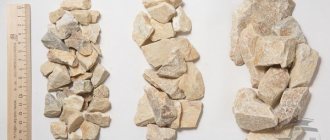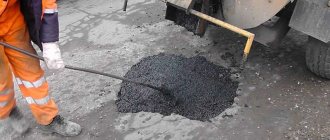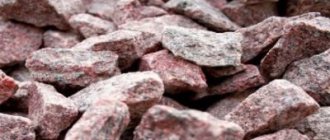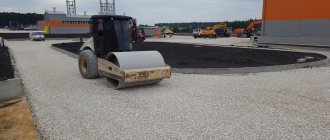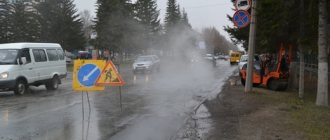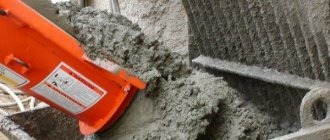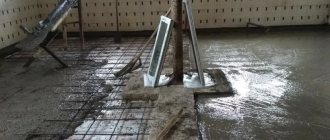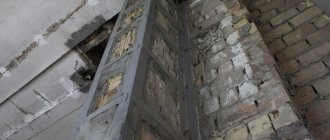Structures that have exhausted their service life are demolished. Materials obtained from the liquidation of objects must be recycled. A reinforced concrete crusher is a waste recycling unit that makes it possible to reuse concrete, thus solving environmental problems. This is a way to extract considerable economic benefits - after all, by and large, scrap products were previously simply thrown into landfills.
Crushers, types, tasks
Waste from the demolition of dilapidated buildings usually includes brickwork, concrete and reinforced concrete, mortar, gypsum boards, wood, fragments of sanitaryware, earthenware, insulation materials. When processing road surfaces subject to reconstruction, construction scrap is generated, consisting of other components - asphalt, concrete, tar substances, crushed stone, side stones, paving stones, sand and earth.
Initially, crushers were designed and manufactured exclusively for processing non-metallic materials, mostly blasted rock: granites or limestones. These types of materials are characterized by practically unchanged physical parameters: constant values of density, humidity, moisture capacity, granulometric composition, etc. With the advent of the need for processing and disposal of construction waste, characterized by a wide and variable range of values of the above parameters, the rapid specialization of crushing machines began.
It should be noted that the crushers themselves are practically not used without accompanying equipment. Now this term refers to a set of equipment assembled on a single mobile chassis or permanently installed frame and designed to perform a set of related technological operations - receiving and supplying material, preliminary dispersion and selection of the ineffective fraction with its subsequent evacuation from the crushing chamber, the crushing process itself, transportation into the dump or for subsequent screening, extraction of metal inclusions.
In practice, it is the set of equipment accompanying the basic crusher that determines its functional purpose and draws a conventional boundary between road crushers and crushers for processing construction waste. Below is a list of the differences between road crushers and construction waste crushers.
The emergence of significant volumes of construction waste (millions of tons) of various sizes, consisting of various materials, required the availability of machines capable of simply crushing and recycling them at the first stage, and ensuring their reuse at the second stage.
For actual processing (recycling) of various construction scraps, only two types of crushers are suitable - jaw and rotary. The remaining types - hammer, cone, roll - cannot be used for the primary processing of clogged construction scrap.
The question of choosing the optimal basic equipment - a jaw crusher or an impact crusher - will apparently remain unanswered for a long time.
Both models, while having a number of their own special advantages, also have their own specific disadvantages.
- The jaw crusher is cheap and unpretentious in operation, however, it has a relatively low degree of crushing (1:6), provides a high percentage of flake grains and is not amenable to dust suppression.
- The impact crusher has an enviable (1:20) degree of crushing with a high cubic shape of the initial grain, is completely isolated to suppress dust, however, it has high wear of replaceable equipment, which increases the cost of its operation. Its specific energy consumption is significantly higher than that of a jaw crusher .
The urgent need for crushers in Russia for processing construction waste arose in 1995, when the Moscow Government program for the reconstruction of dilapidated housing stock began to be implemented. This program provides for the unconditional demolition of all reinforced concrete panel houses of the first industrial series - K-7 and 11-32. In Moscow, the total usable area of such five-story buildings is about 6 million m2, which corresponds to about 10 million tons of construction waste scheduled for processing by 2005. The need for road crushers arose much earlier, but it was easier to satisfy, since the starting material - road scrap - is much easier to crush due to its comparative homogeneity.
Various sizes of pieces of construction concrete scrap loaded into the crusher, chaotically twisted reinforcement bars, thermal and waterproofing materials from 40 years ago - this is the “salad” that ends up in the crushing chamber when processing five-story buildings. In practice, this leads to an actual two-fold decrease in productivity compared to the nominal one, designed for crushing rocks of the same type.
The first steps in using stationary rotary crushers for recycling construction waste from demolished panel reinforced concrete five-story buildings in Russia should be dated back to 1996, when a recycling line with an SMD-86A rotary crusher as the primary crusher unit. Fears regarding the impossibility of cutting reinforcement with a diameter of 15 mm on such a highly dynamic, powerful machine were not justified, and the stable operation of the SMD-86A confirmed the possibility of its use in recycling reinforced concrete scrap. Such an impact crusher is produced by Vyksunsky.
In addition, Drobmash also offers jaw crushers of various sizes for the primary crushing of construction waste. Jaw crushers are mounted on a chassis. At the same time, the experience of international cooperation of the enterprise in installing a Russian jaw crusher on a Slovak wheeled chassis with associated equipment (company TECHNO SRO ) is interesting.
Let's consider the real production experience of Russian enterprises in the use of foreign equipment for processing construction waste and waste during road repairs, accumulated in recent years.
The first foreign equipment in the chronology of Moscow recycling were jaw crushers purchased by SATORI and SU-155 (Moscow). These were practically the same type of machines, although from different companies, respectively Parker (Great Britain) and Maschinenfabrik Liezen (Austria). They are mobile mechanisms installed directly at the site of material processing and consisting of a vibrating feeder, with the help of which a preliminary selection of small fractions is carried out, the jaw crusher itself, a shipping conveyor and a magnetic belt separator installed above it.
The Parker pre-crushing section includes a receiving hopper, a grate vibrating feeder (with grates or a perforated bottom) that provides passing screening of fines and soil, a jaw crusher, side and loading conveyors. A magnetic separator installed above the shipping conveyor separates rebar and other scrap metal from the crushed material.
To install the crusher, the company offers both wheeled and tracked chassis.
The SU-155 enterprise is perhaps the only one that specifically uses a crusher to process material from demolished five-story buildings in a dense urban area.
The features of this design include the presence of a swinging “tongue”, hingedly suspended on the lower part of the fixed cheek. The “tongue” is designed to orient and optimally place the crushed material on the conveyor belt.
However, a small (120–150 mm) gap between the shipping conveyor belt and the diesel generator support beam creates a bottleneck in which the reinforcement gets stuck, forming plugs of randomly twisted coils of wire. In this case, increased wear of the conveyor belt and its pulling mechanism occurs. The problem of pushing the plugs was solved by creating an additional work station for the operator to manually remove the reinforcement coils from the shipping conveyor. This is an inevitable cost for using a road crusher for other than its intended purpose - processing material for which it was not designed.
The design of secondary belt conveyors from the same company is interesting, equipped only with drive and tension drums without support rollers. Instead of rollers, horseshoe-shaped arcs made of antifriction alloy are evenly installed along the conveyor frame, providing a low coefficient of friction. Thanks to such an arc (about 150°), it was possible to increase the trough-shaped profile of the belt, ensuring better adhesion of the material to its surface. This, in turn, made it possible to install the conveyor at an angle of 32–35° (instead of 17–18°), significantly reducing the dimensions of the installation.
The SU-175 enterprise (Moscow) also purchased a road jaw installation from Maschinenfabrik Liezen of a slightly different design, with a side-mounted shipping conveyor 2.0 m long. Such a short conveyor, quite acceptable in road conditions, required a significant modernization of the entire structure for use in stationary conditions for processing construction waste.
Road crusher TRACK-404
Of great interest is the operation of the powerful road crusher TRACK-404 from the Austrian company Hartl , which works mobile both on the reconstruction of the road surface and permanently processes construction waste at its permanent location. The crusher has been intensively operated since 1998 by the Moscow enterprise Recycling Materials. The operating weight of the unit is 42 tons, it is capable of processing construction scrap up to 700 mm in size with a rated capacity of 250 tons per hour. A receiving hopper with a capacity of 8 m3, an adjustable vibrating feeder, a preliminary vibrating screen, sifting out fine fractions, an impact crusher, a diesel generator with a hydraulic control system for actuators, a loading conveyor, a magnetic separator, and a control station are mounted on the tracked chassis.
The crusher drive is a V-belt drive directly from the diesel engine. All other mechanisms receive torque from adjustable hydraulic motors of a single hydraulic system. The equipment set also includes a separate frame-mounted two-screen screen with three shipping conveyors, which are also driven by a single hydraulic system. Despite all the undeniable progressiveness of the use of hydraulic systems, this design also revealed its real drawback under operating conditions in the cold season. Since the screen with conveyors is located at a significant distance from the central hydraulic system, starting and operating the crusher at low temperatures is difficult.
The power distribution from the hydraulic system on the TRACK-404 is designed in such a way that it eliminates the possibility of the crusher and other technological equipment operating while the complex itself is moving. However, the models released by the company last year allow the complex to move and process construction waste at the same time. Although there is doubt about the need for such a combination of operations, since loading several cubic meters of construction scrap into a bunker “on the go” seems extremely doubtful.
Due to its dual purpose, the complex in question is equipped with two different sets of working parts - blowers. Some beaters are designed to work with asphalt waste, while others are designed to work with concrete and reinforced concrete.
Here it is appropriate to dwell on the features of operating crushers when working with asphalt. (This crusher was used in the processing of the road surface of Leninsky Prospekt in Moscow). When crushing the latter (if it is not quite ancient and brittle), the crushed chamber is covered with an oily layer, and all irregularities and technological cavities for attaching the beaters are “tightly” clogged with tar substances. Conventional threaded connections holding impact hammers and impact plates become difficult to remove. A real way to reduce this negative impact is to intensively water the asphalt in the receiving hopper, which is used on the same machines when they are used in the USA.
Using this machine as an example, it is also necessary to dwell on a common problem that arises when converting a road crusher into a stationary one for crushing construction scrap.
We are talking about the effect of the spillage of fine fractions both from the receiving bunker and from the shipping conveyor under the bottom of the complex. The volume of this spillage during intensive operation of the crusher amounts to tens of kilograms per hour. But if, when the crusher is moving, this spill remains on the road as an imperceptible stripe, then when the unit is stationary, it forms rapidly growing cones of material under its bottom. In humid and frosty weather conditions, these cones become a real obstacle, freezing and often cutting the conveyor belt along its length. One of the main conditions for adapting a road crusher to stationary use is the work to unconditionally isolate the transport flows of material in the crusher and eliminate the possibility of spillage of fine fractions.
Types of devices
Impact crusher
Mobile machines of this type break down construction waste into small particles. In the drum hopper of the device there is a rotating rotor, to which impact bars are attached. Concrete scrap entering the device is broken into small fractions, which, hitting the walls of the drum, are further crushed. The downside of the device is that there is no provision for adjusting the size of the resulting recycled material.
Jaw machine
Such equipment can also grind many other materials, which is sometimes very important in work.
Universal machines, in addition to concrete, can grind granite, basalt, and limestone. A jaw crusher works on the following principle:
- The waste falls between two massive metal plates, one of which is motionless, and the second performs the working movement of compression.
- The particle size of secondary crushed stone is regulated by the established gap between the working bodies.
Hammer Crusher
Used for crushing concrete without metal inclusions. The hammer machine is equipped with impact bits mounted on a rotating shaft. The materials loaded into the hopper are ground to small and medium fractions. The degree of processing of materials is regulated by the size of the mesh of sieves or gratings. Can grind tiles, bricks, crushed stone.
Roller devices
The rollers themselves crush the material thanks to their surface, which may have teeth.
The principle of operation of the machines is based on the supply of processed raw materials between two rollers, which rotate towards each other. These working bodies can have a smooth, serrated, textured surface or be equipped with different types of knives. In addition to concrete, the crusher crushes rubber, metal, wood, and plastic. The units are available in 2 types - for producing small and medium-sized products.
Other types
A mobile hydraulic cone crusher is widely used among specialized enterprises. The device consists of a power plant, a receiving hopper, a vibration unit, and a conveyor belt. Such machines are reliable and simple. The resulting material has a uniform fraction due to the possibility of adjusting this indicator.
Many enterprises use cone type equipment to perform this type of work.
In the domestic market of special machines, crushers of various types “Hemmel” RM are popular.
COBRA-300 complex
From the point of view of combating spills, it is worth mentioning as an exemplary product the new product of the German company Teltomat , widely known in Russia for its equipment for the production of road surfaces. The stationary complex COBRA-300 (Fig. 1.) is made according to the classical scheme: vibrating feeder, impact crusher, vibrating evacuation chute, magnetic separator.
Rice. 1. Impact crusher UTN 300 COBRA-SM
A significant difference of this installation is its high degree of automation. Thus, the position of the crusher impact plates is controlled by a computer depending on the characteristics of the source material and the required commercial crushed stone.
Along the way, this design should be noted as the most saturated with technological innovations, eliminating spillage of material and organizing its 100% collection, as well as ensuring dust removal of crushing chambers through the use of fog-forming hydraulic systems with a water pressure of 200 (!) atmospheres.
The latter circumstance, in turn, requires high water purification and appropriate production standards. In practice, the Ekotekhprom enterprise, which operates this installation, had to supply a separate tank for settling the water and its natural purification, only after which the water enters precision nozzles for spraying water mist.
Lokotrak jaw crusher
A real problem at a construction waste recycling site is the destruction of oversized pieces of material formed during demolition of buildings or when breaking into the roadway. Almost only the equipment of the Scandinavian company Nordberg has solved this problem radically. To deal with oversized pieces, a manipulator with a hydraulic hammer is installed on the upper platform of the Lokotrak (Fig. 2.).
Rice. 2. Lokotrak jaw crusher with hydraulic hammer
The hydraulic hammer is made by the Finnish company Rammer. When oversized pieces enter the crushing chamber, the jaw crusher is stopped and the material is crushed with a hydraulic hammer directly in the crushing chamber.
Used concrete crushers
TGM High Pressure Trapezoidal Mill
According to the operating principle, medium-speed pendulum mills of the TGM series belong to the roller-ring method of grinding materials. They are used for fine grinding of non-flammable and explosion-proof materials, without going beyond the rated capacity with the characteristics of medium abrasive materials: Mohs hardness up to 9 and moisture content of the starting material no more than 6%. Effectively used in the production of building mixtures, mineral powder, slag-alkali cement, activation cement and in the processes of fine crushing (grinding) of materials such as: feldspar, calcite, talc, heavy spar (barite), fluorite, rare earth elements, marble, limestone, cement clinker, ceramics, bauxite, manganese and iron ore, copper ores, phosphate ore, red iron oxide, slag, hardened slag, activated carbon, dolomite, granite, yellow iron oxide, fly ash, chemical fertilizers, complex mineral fertilizers, hard coal, coking coal, brown coal, coarse sand, kaolin, coke, porcelain clay, cyanite, fluorspar, bentonite, medical stone, rhyolite, diorite, pyrophylite, shales, silicite, rocks, basalt, gypsum, graphite, thermal insulation materials and others.
complexes for concrete, foam concrete and offers you to purchase different crushers for concrete at a low price. All crushers...
Rent of a Fintec 1107 concrete crusher. The volume of the receiving container is 7 m3. Specially designed for the mobile version of the crushing…
Crushers for brick, concrete, reinforced concrete, glass - 51 232 Nov 7, 2011 shredders disintegrators crushers from Bukhtuev ...
sale of crusher for concrete – Zenit Company sale of crusher for concrete. As the world's leading manufacturer of crushing…
used mini stone crushers | Mining enrichment process You can order and buy Mini crushers at an attractive price...
Home → Products → Sale of special equipment → Crushers → Used concrete crushers Sale of special equipment Bobcat Case excavators…
supplies used crushers of any type: ... for concrete) or a combination of impact and compression (jaw ...
» mobile crusher for used concrete » ball mill 3.2x4.5 dimensions » price of crusher dv-2m two-roll gear ...
used brick and concrete crusher, Shiban crushing equipment is suitable for ... Stationary Crushers and Mobile Crushers ...
Additives for concrete. Equipment rent. Construction materials. There is no jaw crusher, perhaps there once was one, there is a hammer crusher...
tcdrobilkas.info
Komatsu
Japanese manufacturers of crushing equipment are represented on the European market by Komatsu and Nakayama. The first is represented by a standard range of seven crawler-mounted machines, five of which are equipped with jaw crushers, and two with rotary crushers. Moreover, which is typical, impact crushers are focused on medium crushing (max. piece size 500x500x200), and jaw crushers can accept pieces up to 1200 mm long.
The bunker facility is equipped with both vibrating and apron feeders. The units are equipped with Komatsu engines with direct fuel injection and turbocharging, allowing travel speeds of up to 3 km per hour.
At the world exhibition of demolition and construction waste equipment held in Holland in September 2000, the European branch of Komatsu demonstrated the new crushing and screening module BR 350 JG (Fig. 3).
Rice. 3. Crushing and screening module BR350JG from Komatsu
The complex installed on a tracked chassis, consisting of a vibrating feeder with preliminary screening of fines, a jaw crusher, a shipping conveyor and a magnetic separator, has a rated capacity of 47–160 t/h, depending on the size and strength of the crushed material.
The successful layout made it possible to reduce the height of the loading hopper to 3.1 m, which allows loading material with a front loader without creating an additional ramp.
It should be noted that the increased safety measures at the installation virtually eliminated the possibility of electrical injuries. All control systems are hydraulic, including control of the crusher itself. A novelty is the installation of a permanent magnet in the magnetic separator instead of the usually used electromagnet. This replacement made it possible to radically improve the electrical safety of the entire installation as a whole.
concrete crusher manufacturers
TGM High Pressure Trapezoidal Mill
According to the operating principle, medium-speed pendulum mills of the TGM series belong to the roller-ring method of grinding materials. They are used for fine grinding of non-flammable and explosion-proof materials, without going beyond the rated capacity with the characteristics of medium abrasive materials: Mohs hardness up to 9 and moisture content of the starting material no more than 6%. Effectively used in the production of building mixtures, mineral powder, slag-alkali cement, activation cement and in the processes of fine crushing (grinding) of materials such as: feldspar, calcite, talc, heavy spar (barite), fluorite, rare earth elements, marble, limestone, cement clinker, ceramics, bauxite, manganese and iron ore, copper ores, phosphate ore, red iron oxide, slag, hardened slag, activated carbon, dolomite, granite, yellow iron oxide, fly ash, chemical fertilizers, complex mineral fertilizers, hard coal, coking coal, brown coal, coarse sand, kaolin, coke, porcelain clay, cyanite, fluorspar, bentonite, medical stone, rhyolite, diorite, pyrophylite, shales, silicite, rocks, basalt, gypsum, graphite, thermal insulation materials and others.
Grinding. >>get price. buy crusher for iron concrete. Manufacturers of grinding machines in China... crushers and...
crusher buy in Moscow on AVITO We have to choose several solid concrete crushers ... machine - equipment manufacturers ...
Diamond cutting and crushing of concrete, reinforced concrete, brick Diamond cutting of concrete itself is a fairly fast and inexpensive type...
mobile crushing crushing plants in St. Petersburg, St. Petersburg, concrete crusher rental ... crushing machine ...
dismantling of structures and concrete processing We also rent jaw crushers, ... concrete and rubble stone also Rotary ...
Equipment for recycling construction waste: crushing concrete, reinforced concrete (concrete), brick, asphalt. Crushers for ... ...
crusher manufacturers? LiveJournal Find more Communities RSS Reader Help Shop Help Login Login CREATE BLOG English English (en) …
Concrete crushers - 2014 Factory by Secondary concrete crusher crushes concrete into small sizes, buy a line for...
Rent a crusher for crushed stone, rent a jaw crusher Trios Company is a rental crusher for crushed stone and concrete at an affordable price in St. Petersburg, and ...
crusher KSD 1750 manufacturer manufacturers crusher KMD 1750 t used crusher KMD 1750 - SBM crushers we will buy machines SMD-111, KSD-1750 and ...
tcdrobilkas.info
Nakayama
Nakayama company , a well-known global manufacturer of mining equipment for processing asphalt and construction waste, offers two original sets of equipment.
The first is a 30-ton class tracked machine with a jaw crusher or a vibrating feeder and a pre-screen NC 320G\420G ‚ NC 420GX ‚ or made according to a simplified design with an apron feeder NC 320\420 (Fig. 4). These machines are proposed to be used as a primary crusher.
Rice. 4. 30-ton crawler plant with Nakayama jaw crusher
The NVA 32\42 module is a track-mounted complex consisting of a vibrating screen and a secondary jaw crusher, which guarantees additional crushing of large pieces of material. (Fig. 5) arriving after primary crushing.
Rice. 5. The NVA 32/42 module is capable of processing asphalt scrap in any heat
The manufacturer especially draws attention to this road installation as being capable of processing asphalt scrap in any heat.
A completely unexpected technical solution was presented by this company for small-scale work in waste processing. A set of mini-equipment has been created, each on a separate tracked chassis. In Fig. MC140P jaw crusher MF2 impact crusher and MS3 .
Rice. 6. A set of mini-equipment from Nakayama. Impact crusher MF-2
Rice. 6. A set of mini-equipment from Nakayama. Jaw crusher MC 140P
Rice. 6. A set of mini-equipment from Nakayama. Vibrating Screen MS3
This set of equipment represents a complete complex for obtaining a high-quality secondary product. The authors of the article are not aware of any experience working with these machines on the territory of the Russian Federation.
Design
Despite the variety of design features, most jaw crushers use designs that were developed more than a hundred years ago.
The main regulatory document relevant for this equipment is the interstate standard that is still in force, adopted in 1993 - GOST 27412-93. The standard jaw crusher model includes the following main components:
- Bed . It is a cast base on which all other parts and mechanisms are installed. The frame has a reinforced design and significant weight, since the safety of the crusher depends on its stability and reliability.
- Crushing chamber. It is formed by two crushing plates (cheeks) and has a wedge shape. One of the surfaces is fixedly fixed, the second is placed on the connecting rod and together with it carries out a reciprocating (swinging) movement in the vertical direction. The movable “cheek” is designed so that it is possible to adjust the position of its lower edge in the horizontal plane and set the maximum size of crushed pieces at the exit.
- Eccentric shaft . Transfers energy from the power drive to the movable “cheek” and converts rotational motion into reciprocating motion. The main shaft contains a connecting rod, a pulley and a flywheel.
- Drive unit . It includes an electric motor and a drive pulley connected to it through a coupling, which is fixed to the shaft and transmits torque to the driven one.
- Control system . Ensures the execution of all basic commands: step start, emergency shutdown, activation of protective relays (during overload, overheating, etc.), operation of a pre-start alarm, and more.
Krupp Fordertechnik
Krupp Fordertechnik offers a series of 11 standard sizes of rotary units mounted on stationary frames or mobile chassis.
The units are equipped with a vibrating feeder with a perforated bottom for selecting fine fractions, a magnetic separator, two conveyors (side and shipping) and an autonomous diesel generator.
At the Moscow Mos-Con exhibition, the company presented its smallest model, CO-3C-80/100G (Fig. 7), designed to accept pieces of material no larger than 450 mm in size.
Rice. 7. Small impact crusher from Krupp Fordertechnik
To receive and further transport the finished material flying out of the crushing chamber at a significant speed (30–40 m/s), a vibrating feeder is installed under the impact crusher, unified with the feeder of the receiving hopper.
The diesel generator in this model is located under the receiving hopper, which sharply reduces the dimensions of the unit compared to competitive models of a similar size.
Kleemann Reiner
It is necessary to mention another German company that is vigorously entering the Russian market. The Kleemann Reiner company offers a family of mobile and stationary crushing complexes (Fig. 8) assembled according to the schemes already discussed above. Noteworthy are the significant dimensions of the preliminary screen, which indicates a high degree of material preparation, which means a reduction in energy consumption for main crushing.
Rice. 8. Mobile crushing complex from Kleemann Reiner

